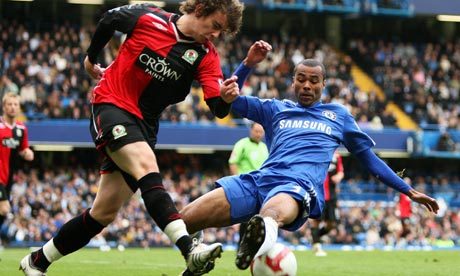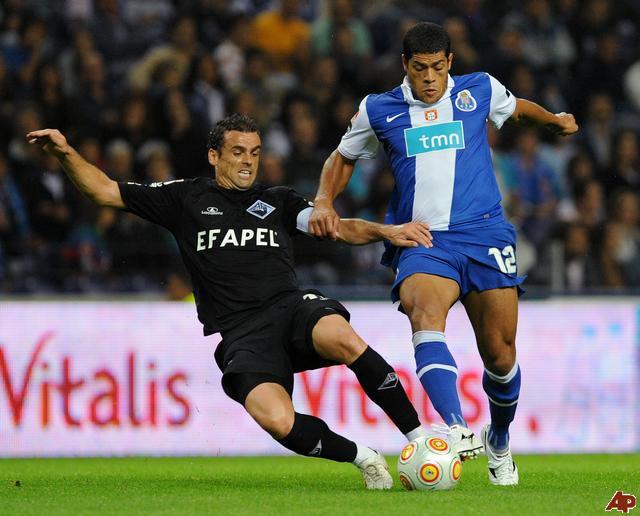-
Recent Articles
Understanding the 4-4-2 Diamond
DEFENCE Despite the fact that there are four ways to play a diamond formation on FM, the differences between them are few and usually subtle. As a starting point, one thing each of them do have...3 at the back and the 4-4-2 Diamond
 Last week Chelsea v Liverpool became the biggest tactical talking point of the season. Liverpool revived the the 3 man defence that Kenny debuted against Stoke. While with the introduction of Torres for £50m...
Last week Chelsea v Liverpool became the biggest tactical talking point of the season. Liverpool revived the the 3 man defence that Kenny debuted against Stoke. While with the introduction of Torres for £50m...How To Set Up A Back Four
 Last year, I wrote a guide about how to play a simple 4-4-2. One of the major components of that is the back four. In fact, most modern formations build upon four defenders; two full backs and two centre...
Last year, I wrote a guide about how to play a simple 4-4-2. One of the major components of that is the back four. In fact, most modern formations build upon four defenders; two full backs and two centre...Building Your Defence: Full Backs
 The modern full back is quickly becoming one of the most important players on the team sheet, infact even back in the days of Brian Clough, fat ed' argued that because of the space these players get in the final...
The modern full back is quickly becoming one of the most important players on the team sheet, infact even back in the days of Brian Clough, fat ed' argued that because of the space these players get in the final...False Nine Tactics
 When we think about modern football trends, we think about the fall of the 4-4-2, the introduction of inverted wingers and the rise of the 4-5-1. But there is one other tactical rise that seems to have...
When we think about modern football trends, we think about the fall of the 4-4-2, the introduction of inverted wingers and the rise of the 4-5-1. But there is one other tactical rise that seems to have...
JOIN 19,165 READERS - SUBSCRIBE NOW TO OUR FOOTBALL MANAGER NEWSLETTER
Get the latest FM news & best community content delivered directly to your e-mail inbox!
Tactical Theorems & Frameworks ’09: Strategy Assumptions
Written by: Richard Claydon
Category: Strategy
Posted on: November 23, 2008
November 23, 2008
Match Strategy Theories
This section explains the assumptions behind the Defensive, Standard and Attacking match strategies and details how to translate them into the slider system. It also looks at how you can transform these three strategies into five, adding the Shut Up Shop and Control options to the manager’s armoury.
Strategy Assumptions
Mentality System Assumptions
• For Attacking systems it is assumed that all the Attacking/Support players should be on an attacking mentality, with the Defend players on attacking/normal.
• For Standard systems the DCs and FCs can, but don’t have to, be on defensive or attacking mentalities respectively, with the rest of the team on normal.
• For Defensive systems, it is assumed that all the Defend and Support players should be on defensive mentalities, with Attacking players on defensive/normal.
Passing Assumptions
Passing has to be balanced so that it gets an ideal mix of three properties. A good passing framework should: a) take pressure off the defence; b) retain ball possession; c) create good goal scoring opportunities.
For defensive teams, playing deeper and more cautiously than attacking teams, it is important to make sure the ball is removed from the danger zone quickly. They will usually be weaker than their opposition, or certainly not pushing as hard for a goal, and therefore will want their passing to be incisive in what could be a short amount of time. Attacking sides will want to get the ball down and play it, keep hold of possession and look for the best opportunities to play in team mates for a goal.
Because of this, TT&F ’09 advocates the following frameworks for passing:
Defensive
Defend - direct
Support - mixed
Attack - short
Standard
Defend - low direct
Support - mixed
Attack - low mixed
Attacking
Defend - short
Support - mixed
Attack - direct
The logic behind this is that defensive teams will look to get the ball away from goal, but will then want to concentrate on keeping the ball when they reach the midfield. Because of the narrower width, players should be close enough together to have passing options. Therefore the support players can be on mixed and the attack can use short passing. The team should be able to hold on to the ball, but will only aim to once they have moved out of the defensive third. Since attack is not the prime aim of the game plan, it is assumed that the team can concede a little incisiveness in the final third in order to try and keep the ball. If you have possession, the opposition do not and, therefore, cannot score.
Attacking teams will, on the other hand, need to get the ball and play it well between each other. The defenders are set to short passing so they can look for a good passing option to start an attack. Since they should be under less pressure, they should have the time and the mentality to be able to do this. The attacking players are on direct passing for two reasons. Firstly, it allows much more incisive passing leading to good opportunities to play in players in advanced positions. Secondly, since the players should be more spaced out, a direct passing game gives players more options and allows passes to more easily reach teammates. In most formations the Attack players will be wing players (full backs and wingers), so this allows them to look for options in the centre of the field without the need to always cross the ball. The Support players sit deeper and play dangerous through balls to attacking players, try to revitalise attacks in danger of petering out and aim at quickly recycling half-cleared balls.
Standard tactics’ passing instructions are similar to defensive tactics, but the passing settings are much closer together since there is more neutrality in player roles. It keeps the ball moving in the manner of an attacking tactic, but tries to avoid putting the team under undue pressure with inappropriate short defensive passing.
Tempo Assumptions
Fast tempo is generally a better bet for attacking sides as the more quickly the ball is moved around, the greater the likelihood of space opening up in the final third. A slower tempo means less misplaced passes but enables the opposing team to have more time to get back into position to cover attacks. It is thus better for more defensively minded formations.
There are cultural and weather differences to take into consideration when thinking about the above. Nations in colder climates tend to play a faster tempo game than those in warmer regions. There are a few reasons for this. Firstly, the ball travels more slowly in heavy conditions so a low tempo, short passing game is often unsuitable. Although the ball can zip off a damp pitch, it slows down significantly on a soaking wet one, both of which have led to the development of a direct, fast-paced game in Northern Europe. Secondly, hot and humid conditions will sap player energy, so teams from such climates tend to play a slower tempo, possession-orientated game, leading to the highly technical football of South America, Southern Europe and the better African nations. Thinking about the cultural footballing preferences of the country he is working in will help a manager to quickly find his tactical feet.
NB: Check pitch sizes before deciding on ideal tempo
Width Assumptions
To break a defence down the attacking team needs to use as much of the pitch as possible to open space. In contrast, a defensive team will look to reduce space at every available opportunity. Although a team’s defensive width will naturally be narrower than the attacking one, it will be risky for weaker teams to spread too wide as once they lose possession they will become vulnerable to quick passing movements that exploit space before the formation can regain defensive shape.
There are also cultural differences. Northern European teams tend to spread the ball to the wings with great regularity and expect the wingers and fullbacks to work together to provide plenty of crosses from standard positions. Teams from more technically orientated nations tend to play considerably narrower, aim to control possession in the middle of the park and use rampaging fullbacks or drifting midfielders/attackers to provide width as and when necessary.
NB Check pitch sizes before deciding on ideal width
Time Wasting Assumptions
An attacking team will be looking to score goals and won’t want to waste any time. A defensive team will be hoping not to concede and will therefore aim to take advantage of any stops in play to further wind down the clock. Time wasting also has a few cultural variations. Some nations/leagues have a greater tendency towards defensive play and will employ time wasting far earlier in the game than others. Other cultures believe that attack is the best form of defence and will go forward almost to the final whistle. Both strategies have potential weaknesses. Sitting on a narrow lead for 80 mins can cause a team to collapse under the weight of attacking pressure whilst pushing for the killer goal risks conceding on the counter. Ultimately, the type of time wasting strategy you choose to employ will depend on your trust in your team. Arguably, it is best employed as a dynamic instruction that changes relative to the match situation.
Tackling Assumptions
An attacking team will be looking to win quick ball high up the pitch and will thus throw themselves into tackles. As the majority of tackles will be made in the opposing half it doesn’t matter if they result in a free kick, as it won’t be in a dangerous position. Tackles in such areas are also less likely to get a card. Thus, tackling will be heavy. A defensive team aims to keep players behind the ball and not to make any tackling errors. They will also be pinned back in their own half so can’t afford to give away as many free-kicks, as they will be dangerous and more likely result in a card. Players will only choose to make tackles when they are sure of getting the ball or have no other choice. Thus, tackling will be easy.
Marking Assumptions
Loose and zonal marking generally means a player won’t be close to an opponent when possession changes. These players will immediately be available for an attacking pass. It is the preferred marking instructions for Attacking roles. In contrast, tight and man marking ensures that the player is as close as possible to his opposing man when not in possession. Such players aim to win the ball back and launch passes to the more open, Attacking players to start a counter. It is the preferred instruction for Support and Defend players.
NB: It is more than possible to play zonal and tight, which is often the preferred option for players who have no obvious opponent to mark.
Focus Passing Assumptions
An attacking team will look to exploit the space on the flanks and regularly work the ball into those areas. Thus, for attacking formations, focus passing down flanks. In contrast, a defensive team aims to hit direct balls and thus tend to hit the balls that centrally positioned forwards have a chance of reaching. Thus, for defensive formations, focus passing through the middle.
Formation shape, which is often determined by cultural preferences, impacts upon the best choice of focus passing instructions. A team without wingers might not get the best out of the down the flanks instruction and mixed is likely to be the better option. Likewise, a defensive formation employing a lone FC runs the risk of his being overpowered by the defence before he can lay it off to the midfielders. Mixed will direct more balls into channels for the wingers to chase and might be a better option.
The left/right flanks focus passing options are best employed when you have identified one of your opponent’s flanks as being significantly weaker than the other and wish to take advantage of that weakness.
Creative Freedom Assumptions
Creative freedom, which encourages players to break from the tactical plan and take risks, is of great importance for an attacking strategy but dangerous for a defensive one. The more aggressive the strategy, the more players should be given high creative freedom instructions. Players assigned to Attack roles should be allowed higher creative freedom, Support roles normal and Defend roles lower. However, as detailed in the Frameworks section (pages 12-13) assigning levels of Creative Freedom is as much down to manager type as player roles.
Free Role Assumptions
A free role encourages a player to largely abandon defensive duties and focus on finding attacking space. As with creative freedom, this is highly advantageous for attacking systems but potentially dangerous for defensive ones. However, for every system it is important that one player is looking to create space at all times in order to provide a passing outlet for players under pressure. For each system, at least one Attacking roles need to operate within the formation structure or it will lose defensive stability and attacking organization. However, the others can be given free roles. Hence, Attacking strategies have three free roles, Standard two and Defend one. For the default tactics accompanying this guide, we have made the FCa the standard free role player. This will be fine if he is describes as an FC in the game. For STs, it is best to apply free roles elsewhere, as they do not make best use of the instruction.
NB: With top-class players, or when employing a playmaker or libero, you can increase free roles. However, doing so with a poor team will be disastrous.
About The Author: Richard Claydon
Tactical theory has evolved massively down the years, from Diablo-style beat-’em-alls through Cleon’s era to the present day systems inspired by wwfan’s theories. Richard is considered to be the authority on FM tactics, and was approached by Sports Interactive to help write the new tactical interface in Football Manager Live and Football Manager 2010.
Download Our Tactical Theorems '10 eBook Absolutely Free

Presenting the most comprehensive tactic design and match strategy guide to the Football Manager series ever created!
Written by FM match engine beta testers, it's 60+ pages of easy-to-read concepts and ideologies for getting your team playing exactly how you want each match! It's been downloaded over 100,000+ times to date!
Find out more information about our tactical eBook
and download Tactical Theorems '10 right now!
Written by FM match engine beta testers, it's 60+ pages of easy-to-read concepts and ideologies for getting your team playing exactly how you want each match! It's been downloaded over 100,000+ times to date!
and download Tactical Theorems '10 right now!



